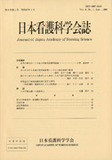Japanese
English
- 販売していません
- Abstract 文献概要
- 参考文献 Reference
要旨
寝たきり老人が昇降装置付浴槽を利用して自動動作をほとんど行うことなく全面的に介助を受けて入浴する場合の生体負担について調べた.テレメーターを用いて入浴中も心拍を連続的に測定し,その変化から負荷の程度を推定した.入浴に伴う他動的な体動や湯浸の刺激などに対応して心拍数の増加が認められた.入浴を脱衣・移動,洗浄,湯浸,移動・着衣に4区分してその負荷の程度を調べると,対象者8名中5名においては洗浄あるいは湯浸中に心拍数は最大となった.一方他の3名は刺激に対応した心拍の変化は全体的に緩かで,洗浄や湯浸中に著しい増加は認められなかった.入浴中平均心拍数の安静時心拍数に対する比は8名の平均で1.20±0.08となり,これを通常の自立入浴法での労作に比較するとエネルギー代謝率(R.M.R.)でほぼ1/3に相当すると推定された.また被験者間に観察された反応の差については今後の研究課題であることを示唆した.
Abstract
The workload incurreds on bedridden elderly was studied during a complete passive bathing. The 8 subjects were bathed in a special bath system while maintaining the supine positions without active movements, using mechanical help and staff assistance. The heart rate (HR) was measured with a telemetric instrument throughout the whole procedure to estimate the workload. The whole bathing procedure were classified into 4 stages; removing of clothes-transportation , washing, immersion in water and transportation-putting on clothes. The HR chaged with each bathing procedure with maximum HR occuring at the second or third stage in 5 of all the subjects. In the other 3 subjects, there was no apparent increase in HR. The ratio of the HR during the whole procedure to that of the resting time ranged from 1.06 to 1.29, and averaged 1 .20 in the 8 subjects. The physiologic costs of whole bathing procedure by this system was estimated to be about 1/3 of that of bathing by oneself. Individual differences observed in HR changes among the subjects were discussed with reference to implications for further study.
Copyright © 1988, Japan Academy of Nursing Science. All rights reserved.


